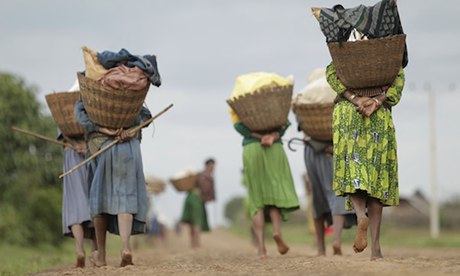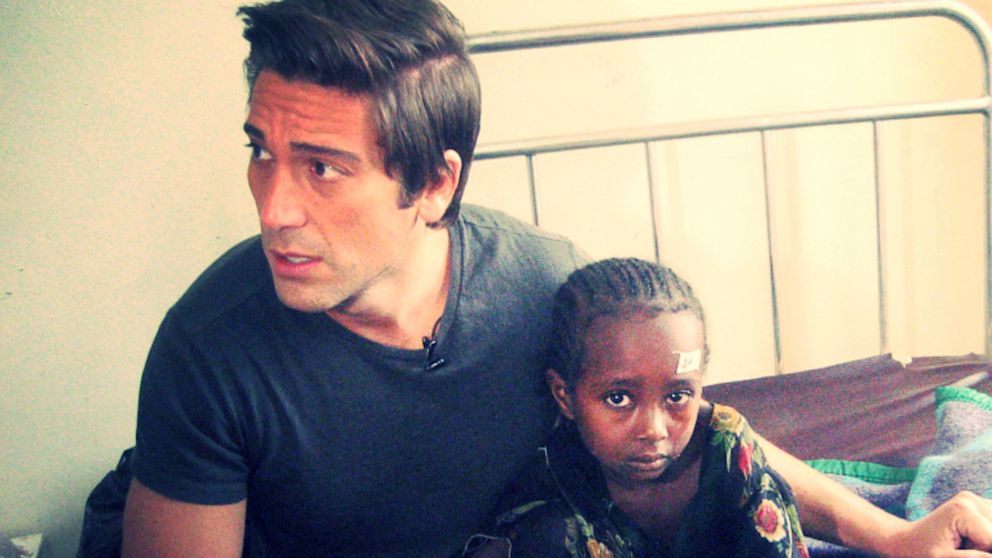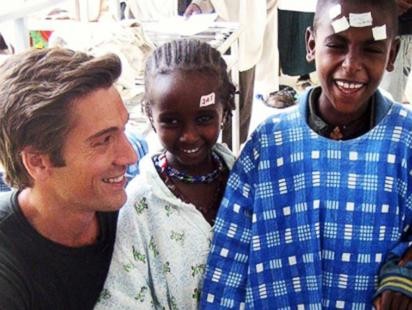Mass breastfeeding record attempt in Philippines: 300 mothers feed babies together - YouTube: ""
'via Blog this'
Wednesday, October 30, 2013
Tuesday, October 29, 2013
Mapping elephantiasis in Ethiopia | Global Development Professionals Network | Guardian Professional
Ethiopia now has a national plan for eliminating neglected tropical diseases, but success depends on disease mapping, monitoring, and making data accessible for policymakers
- Kebede Deribe in Addis Ababa
- Guardian Professional,

Elephantiasis can be caused by regular contact with volcanic red clay soil that irritates the skin. Photograph: Wellcome Trust
There are two principal causes of elephantiasis, or lymphoedema, in the tropics. The most common cause, and already known to be a significant public health problem, is lymphatic filariasis (LF). The other main cause is podoconiosis: a form of elephantiasis arising in barefoot subsistence farmers who are in long-term contact with irritant red clay soil of volcanic origins.
The disability associated with elephantiasis creates considerable stigma, and reduces productivity in patients. According to a study in Ethiopia, published by Tropical Medicine and International Health, the total direct costs of podoconiosis amounted to the equivalent of $143 (£88) per patient per year and a productivity loss of 45% of total working days per year.
Ethiopia recently launched its national master plan (2013-2015) for neglected tropical diseases, and podoconiosis and LF are two of the eight NTDs prioritised within it. In order to achieve the goals of this plan, health and development organisations will need a clear understanding of the geographical distribution and burden of the diseases. With that knowledge, they will be able to target priority areas and determine geographical overlaps among the disases to enable integrated control.
Elephantiasis is one of the NTDs with a clear potential for elimination. LF infection can be prevented and treated with a combination of medicines, while podoconiosis is easily preventable if shoes are consistently worn, and early stages can be successfully treated. For those who developed advanced disease of either cause there are proven ways to manage symptoms and prevent disabilities. Nonetheless control and elimination efforts can be hampered by a lack of information on the geographical distribution of the diseases.
One of the best ways to overcome this problem is by using integrated mapping. Mapping can help to identify populations at risk of diseases, indicate priority areas, target resources and help to monitor control progress.
A new initiative to map LF and podoconiosis in Ethiopia is underway, through a collaboration between several organisations. Supported by the Wellcome Trust, DfID and End Fund, the Ethiopian Health and Nutrition Research Institute (Ehnri) is working with Brighton and Sussex Medical School (BSMS), the Centre for Neglected Tropical Diseases, the Global Atlas of Helminth Infections at the London School of Hygiene & Tropical Medicine to map 1,384 communities in 692 districts, covering more than 130,000 individuals.
A total of 136 health providers have come together into 34 teams to survey the districts throughout the country. Each team includes a health officer, two nurses and a laboratory technician. The teams all receive training on data collection and diagnostic tools from experts from Ehnri and BSMS. Each of the 34 teams select two communities per district [with district health offices] based on reported cases of elephantiasis from health facilities.
About 100 individuals from each community are then randomly selected and included in the study. LF is diagnosed based on immunochromatography tests, while podoconiosis is diagnosed by excluding other causes of lymphoedema, supplemented by antifilarial antibody tests. The data is recorded using mobile phones collection to overcome the costs and challenges posed by paper-based surveys. For example, copying, transporting abnd storing forms can be expensive, and manual data entry often brings around errors.
For integrated LF and podoconiosis mapping, text messages are used to report number of cases of diseases under surveillance, and to help encourage patients to take medications. A big advantage of using smart phones is that they have built-in global positioning systems (GPS) to instantly capture geographic co-ordinates, which otherwise would have been collected using external handheld GPS devices. Results can be electronically entered at the point of data collection, transferred to a central database and analysed immediately after collection by researchers in Ethiopia.
The integrated mapping data collection has not been without its challenges. First, there is no rapid diagnostic test for podoconiosis. The diagnosis is established by excluding other causes of lymphoedema, and at times this is cumbersome for health providers. Second, althoughaccess to mobile phones is rapidly growing in Ethiopia, not all districts have network coverage, which can result in a backlog of data from the field.
However, the multi-organistion partnership has brought together national and global experiences in mapping and use of technologies. The collaboration with Ethiopian health ministry through Ehnri is expected to enhance uptake and country ownership of health data and maps more broadly.
The maps will be available for decision makers at national, regional and district level through publication and online databases. This will allow the Ethiopian health ministry and partners working on LF and podoconiosis to plan properly and better target their interventions to eliminate the disease.
You can find pictures showing the different stages of the integrated mapping process in this gallery.
Kebede Deribe is a research training fellow at the Wellcome Trust. Follow @KebedeDeribe on Twitter
This content is brought to you by Guardian Professional. To get more articles like this direct to your inbox, sign up free to become a member of the Global Development Professionals Network
Thursday, October 10, 2013
Gift of Sight: US Doctor's $11 Fix for Epidemic - ABC News
By ERIN MCLAUGHLIN, CHRISTINE ROMO and DAVID MUIR

via NIGHTLINE
----------------------------------------------------
DAVID MUIRMore From David »
Weekend Anchor, "World News"
ERIN MCLAUGHLINMore From Erin »

----------------------------------------------------
Forty million people worldwide live in total darkness and 90 percent of them live in the developing world.
However, three out of four such cases are reversible, according to Dr. Geoffrey Tabin, director of the division of international ophthalmology at the John A. Moran Eye Center.
Tabin spends a large part of the year traveling around the world restoring sight to thousands of people with cataract blindness.
ABC News joined him on a recent trip 8,000 miles from Tabin's home in Park City, Utah, to Ethiopia, which has one of the highest rates of blindness in the world.
PHOTOS: Curing Blindness in Ethiopia
| Cataract blindness is an epidemic in Ethiopia, and doctors point to poverty, poor nutrition, genetics and the scorching sun as reasons for the devastating numbers. |
When the ABC News team arrived at the Quiha Zonal Hospital in the remote city of Mekelle, Ethiopia, there were already hundreds of patients waiting for Tabin.
For the patients, the journey to Mekelle was a pilgrimage of sorts.
They came from cities, villages and small farming communities throughout Ethiopia to see Tabin. Getting to the clinic was no small feat considering their condition. Many had traveled for days.
Cataract blindness is an epidemic in Ethiopia, and doctors point to poverty, poor nutrition, genetics and the scorching sun as reasons for the devastating numbers.
Upon their arrival, each patient was screened, prepped by a nurse and marked with a small piece of tape with a number above their eyes. As part of the testing, the nurses held up fingers in front of the patients' eyes -- most of whom stared ahead with blank faces.
Tabin said seeing the line of patients waiting for his help was powerful.
"It's daunting, but also exciting. You know, when I'm operating, every single eye is a life," Tabin said.
Some of the patients were young children, including 8-year-old Mahlik, who had cataracts in both eyes.
"He can't see the blackboard. He can't see to study," Tabin said, "and we'll be able to help him completely."
Tabin travels light. All of his equipment fits in just one yellow duffel bag.
He and his partner, Dr. Sanduk Ruit of Nepal, have perfected this amazing sight-restoring surgery, with the goal of curing preventable blindness around the world.
The two of them have sought out the blind all over the developing world.
They founded the Himalayan Cataract Project and, together with their teams, have performed more than 500,000 surgeries worldwide, restoring sight to children and adults who otherwise would be forced to live in darkness.
A recently released book, "Second Suns: Two Doctors and Their Amazing Quest to Restore Sight and Save Lives," by David Oliver Relin, chronicled the doctors' work in the Himalayas and Sub-Saharan Africa.
The simple surgery takes just seven minutes and costs only $11.
The doctor makes a quick incision, removes the cataract in one piece and puts a new lens in its place.
ABC News followed the doctor and his team for three days. During that time, every single bed in the operating room was occupied and lines stretched around the hospital.
Patients left with bandages over their eyes and returned hopeful the next day.
"These are all patients that were completely blind, where they could not see the shadow of their hand move this close to their face one day ago," Tabin said. "These people haven't been able to see in up to 10 years, and they're going to be seeing again for the first time."
Patients were lined up early around the hospital waiting for the doctor to remove their bandages.
"I love that delayed moment because, when the patch comes off, it takes a couple of seconds to register, and people realize they can see," he said.
Subscribe to:
Posts (Atom)


